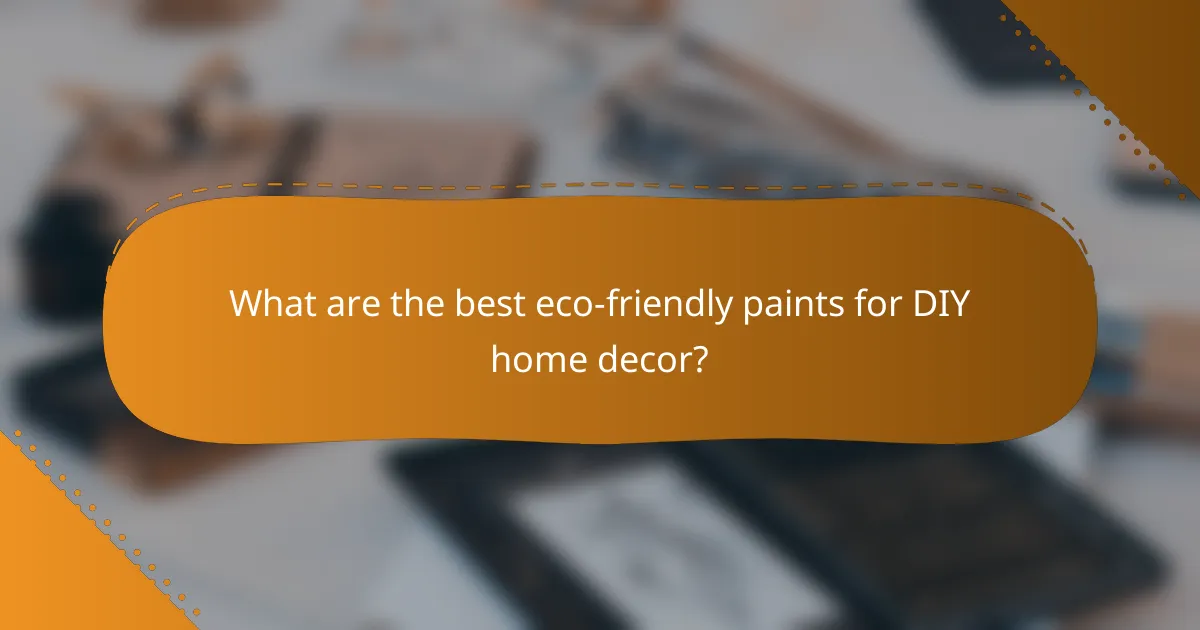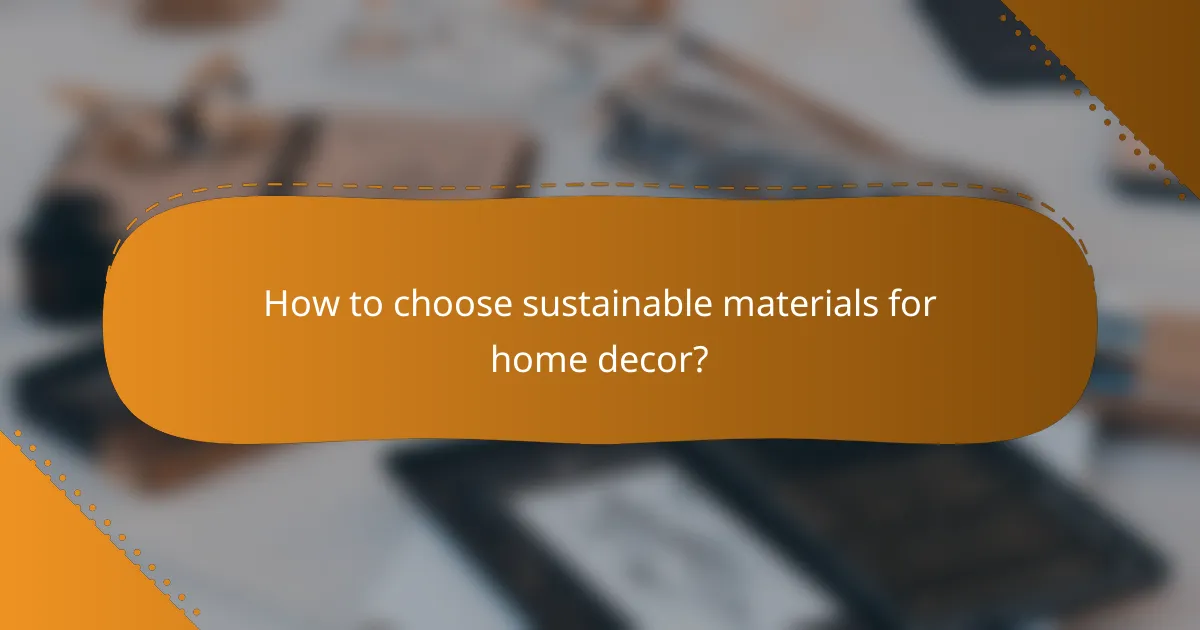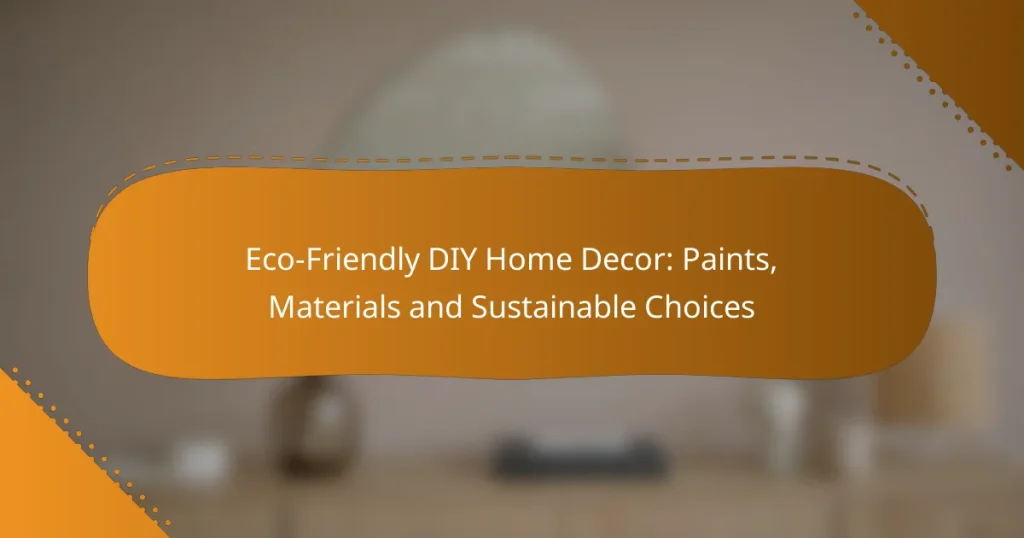Transforming your home with eco-friendly DIY decor not only enhances your living space but also promotes sustainability. By selecting low-VOC and natural paints, along with responsibly sourced materials, you can create a beautiful environment that prioritizes both health and the planet. Embrace these sustainable choices to enjoy a stylish home while minimizing your environmental impact.

What are the best eco-friendly paints for DIY home decor?
The best eco-friendly paints for DIY home decor are those that minimize harmful emissions and use sustainable materials. Options like low-VOC, natural, and milk paints are popular choices that provide both safety and aesthetic appeal.
Low-VOC Paints
Low-VOC (volatile organic compounds) paints are designed to emit fewer harmful chemicals into the air, making them a healthier choice for indoor environments. These paints typically have VOC levels below 50 grams per liter, which is significantly lower than traditional paints.
When selecting low-VOC paints, look for certifications such as Green Seal or GREENGUARD, which ensure that the products meet strict environmental standards. Brands often provide a range of colors and finishes, allowing for creative flexibility without compromising air quality.
Natural Paints
Natural paints are made from renewable resources, such as plant oils, resins, and natural pigments. They are free from synthetic chemicals, making them biodegradable and non-toxic. These paints often have a unique texture and finish that can add character to your home.
Consider using natural paints for areas where children or pets spend time, as they are safer alternatives. However, keep in mind that they may require more frequent touch-ups compared to conventional paints due to their less durable nature.
Milk Paint
Milk paint is a traditional, eco-friendly option made from milk protein, lime, and natural pigments. It is non-toxic and can be used on various surfaces, providing a matte finish that is popular for rustic decor styles.
This type of paint is easy to mix and customize, allowing DIY enthusiasts to create unique colors. However, milk paint may need a topcoat for durability, especially in high-traffic areas, to protect against wear and moisture.
Eco-Friendly Spray Paints
Eco-friendly spray paints are formulated to reduce harmful emissions while providing the convenience of spray application. Many brands offer low-VOC or water-based options that are less toxic than traditional spray paints.
When using eco-friendly spray paints, ensure proper ventilation and follow the manufacturer’s instructions for best results. These paints are ideal for quick touch-ups or projects where a smooth finish is desired.
Brands like Benjamin Moore and Sherwin-Williams
Brands such as Benjamin Moore and Sherwin-Williams offer eco-friendly paint lines that cater to environmentally conscious consumers. Their products often include low-VOC and zero-VOC options, ensuring a safer indoor air quality.
These brands provide extensive color palettes and finishes, making it easy to find the perfect match for your home decor. Additionally, they often have knowledgeable staff who can guide you in selecting the right eco-friendly paint for your project.

How to choose sustainable materials for home decor?
Choosing sustainable materials for home decor involves selecting items that minimize environmental impact while maximizing durability and aesthetics. Look for materials that are sourced responsibly, have a low carbon footprint, and contribute to a healthier living space.
Reclaimed Wood
Reclaimed wood is salvaged from old buildings, barns, or furniture, making it an eco-friendly choice for home decor. It reduces the demand for new timber and often features unique character and history. When selecting reclaimed wood, ensure it is properly treated to avoid pests and contaminants.
Consider using reclaimed wood for furniture, flooring, or decorative accents. Check local suppliers or online marketplaces specializing in reclaimed materials to find options that suit your style and budget.
Bamboo Products
Bamboo is a rapidly renewable resource that grows quickly and requires minimal pesticides, making it an excellent sustainable material. Products made from bamboo, such as furniture, flooring, and kitchenware, are durable and often lightweight.
When choosing bamboo items, look for those certified by organizations like the Forest Stewardship Council (FSC) to ensure responsible sourcing. Bamboo can be a stylish addition to your home while supporting sustainable practices.
Recycled Fabrics
Recycled fabrics are made from post-consumer waste, such as plastic bottles or old textiles, reducing landfill waste and resource consumption. These materials can be used for upholstery, curtains, and decorative pillows, providing a sustainable option for soft furnishings.
When selecting recycled fabrics, check for certifications like Global Recycled Standard (GRS) to ensure quality and sustainability. Look for vibrant colors and patterns that can enhance your decor while being environmentally friendly.
Biodegradable Materials
Biodegradable materials break down naturally over time, reducing long-term waste in landfills. Options include natural fibers like cotton, wool, and jute, which can be used in rugs, curtains, and other decor items.
To make eco-friendly choices, prioritize products that are free from synthetic additives and chemicals. Look for labels indicating biodegradability and consider the lifecycle of the materials to ensure they align with your sustainability goals.

What are the benefits of using eco-friendly home decor?
Using eco-friendly home decor offers numerous advantages, including improved health and reduced environmental harm. By choosing sustainable materials and paints, you create a healthier living space while contributing to the well-being of the planet.
Healthier Indoor Air Quality
Eco-friendly home decor often utilizes low-VOC (volatile organic compounds) paints and materials, which significantly improve indoor air quality. Traditional paints can release harmful chemicals that lead to respiratory issues and other health problems.
By opting for natural paints and finishes, you minimize exposure to these toxins, creating a safer environment for you and your family. Look for products certified by reputable standards, such as Green Seal or GREENGUARD, to ensure they meet strict air quality criteria.
Reduced Environmental Impact
Choosing sustainable materials for home decor helps reduce your overall environmental footprint. Eco-friendly options are often sourced from renewable resources, which means they require less energy and fewer natural resources to produce.
For example, reclaimed wood and bamboo are excellent choices as they are both durable and environmentally friendly. Additionally, many eco-friendly products are designed to be biodegradable or recyclable, further minimizing waste in landfills.
Longer Lasting Products
Eco-friendly home decor items are typically made from high-quality materials that offer greater durability. While they may have a higher upfront cost, these products often last longer than their conventional counterparts, saving you money in the long run.
Investing in sustainable decor means you will likely need to replace items less frequently, reducing waste and the need for new resources. Look for warranties or guarantees that reflect the longevity of these products, ensuring you make a wise investment.

What DIY projects can utilize eco-friendly materials?
Many DIY projects can effectively incorporate eco-friendly materials, promoting sustainability while enhancing your home decor. Common projects include upcycled furniture, eco-friendly wall art, and sustainable lighting fixtures, all of which utilize materials that are less harmful to the environment.
Upcycled Furniture
Upcycling furniture involves repurposing old or discarded pieces into functional and stylish items. Consider sanding down an old wooden chair and applying a non-toxic paint or stain to give it a fresh look. This not only reduces waste but also saves money compared to buying new furniture.
When selecting pieces to upcycle, look for solid wood items that can withstand modifications. Avoid furniture made from particleboard, as it often contains harmful chemicals. Instead, focus on items that can be easily transformed, such as dressers, tables, or even pallets.
Eco-Friendly Wall Art
Creating eco-friendly wall art can be a fun and creative way to personalize your space while being kind to the planet. Use recycled materials like cardboard, fabric scraps, or old magazines to craft unique pieces. Techniques such as collage or decoupage can help you create visually appealing designs.
Consider using low-VOC (volatile organic compounds) paints and adhesives to minimize indoor air pollution. Additionally, sourcing materials from local thrift stores or garage sales can further reduce your carbon footprint while supporting your community.
Sustainable Lighting Fixtures
Designing sustainable lighting fixtures can enhance your home’s ambiance while being energy-efficient. Look for fixtures made from reclaimed wood, bamboo, or recycled metals. These materials not only add character but also help reduce the demand for new resources.
Incorporate LED bulbs into your designs, as they consume significantly less energy and last longer than traditional bulbs. When creating your fixtures, ensure they are easy to disassemble for future repairs or recycling, promoting a circular economy approach.

What are the costs associated with eco-friendly DIY home decor?
The costs of eco-friendly DIY home decor can vary widely based on materials and brands chosen. Generally, you might expect to spend a bit more upfront for sustainable options, but these choices can lead to long-term savings and environmental benefits.
Price Comparison of Eco-Friendly Brands
Eco-friendly brands often range from mid to high price points. For example, natural paints can cost between $30 to $60 per gallon, while conventional paints might be around $15 to $30. Brands like Benjamin Moore and Sherwin-Williams offer low-VOC options that are more expensive but safer for indoor air quality.
When comparing prices, consider the longevity and coverage of the products. Eco-friendly paints may require fewer coats, potentially offsetting the higher initial cost. Always check for certifications like Green Seal or the EPA’s Safer Choice label to ensure you’re getting a genuinely eco-friendly product.
Budget-Friendly DIY Options
For those on a tighter budget, there are several cost-effective ways to achieve eco-friendly decor. Repurposing furniture or using reclaimed wood can significantly reduce costs while minimizing waste. Thrift stores and online marketplaces often have unique items that can be easily updated with eco-friendly paints.
Another option is to create your own natural dyes using ingredients like coffee, tea, or turmeric for fabric projects. This not only saves money but also adds a personal touch to your decor. Look for DIY tutorials that guide you through the process of transforming everyday items into stylish decor without breaking the bank.

How to find local suppliers for sustainable materials?
Finding local suppliers for sustainable materials involves researching businesses that prioritize eco-friendly products. Start by checking online directories, community boards, and local sustainability groups to identify stores that specialize in green materials.
Local Eco-Friendly Stores
Local eco-friendly stores are a great starting point for sourcing sustainable materials. These shops often carry a range of products, including non-toxic paints, reclaimed wood, and organic textiles. Look for stores that are certified by recognized eco-labels, which can indicate a commitment to sustainability.
When visiting these stores, ask staff about their sourcing practices and any certifications their products may hold. Many eco-friendly stores also provide workshops or resources on DIY projects, which can help you make informed choices about materials.
Consider joining local online forums or social media groups focused on sustainability. Members often share recommendations for eco-friendly suppliers in your area, making it easier to find reliable sources for your DIY home decor projects.


